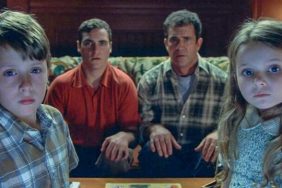It’s Alive: An essay exploring the importance and enduring appeal of Larry Cohen’s 1974 horror classic
Maverick genre film writer, director and innovator Larry Cohen‘s 1974 horror classic It’s Alive is a masterclass in parental paranoia. Cohen was and remains one of the greatest writers for cinema full stop, always showing a sure hand and blending eccentric, believable characterizations, arcane situations, black humor, social commentary and doses of potent violence and – when he’s playing in that sandbox – visceral horror. But in It’s Alive, which in many ways was Cohen’s breakthrough film, his tapping in to the primordial ooze of what it means to be a parent, of the fear and joy of the birth process and the elemental ties we have to whatever child emerges from the womb, is profound. And the ways in which he perverts those emotions and instincts into a blood-spattered nightmare are still — 43 years later — profoundly shocking.
It’s Alive stars John Ryan and Sharron Farrell as Frank and Lenore Davis, a loving couple approaching middle age with one 11-year-old son and now, another child on the way. The movie opens with Lenore waking her husband up announcing that “It’s time” and preparing — calmly, cheerfully — to go to the hospital for the birth. Typical, benign scenes of a nervous husband and wife preparing for that most natural of functions are essayed by Cohen in an almost too saccharine way, with waiting room dad asides and doctors shruggingly going through their routines, creating a deceivingly safe environment.
And then… birth.
“There’s only ONE thing wrong with the Davis baby,” the poster tagline and trailer screamed.
“IT’S ALIVE!”
And alive it is. Inexplicably, Lenore gives birth a a hulking, fanged mutant with claws and a melon-sized noggin and a lethal impulse to shred every human being in reach. As designed by a very young Rick Baker, the It’s Alive baby is widely considered a classic monster and with good reason; it’s scary, absurd and the manifestation of every mother’s worst nightmare. Man, those early Rick Baker monsters were the best, weren’t they? Octaman. The Incredible Melting Man. Just wonderful, innovative and imaginative stuff.

Anyway, the scene in where Frank realizes that something terrible has happened is brilliantly staged, shot and edited by Cohen, with the soundtrack going silent, a doctor emerging from the birthing room holding his torn throat before collapsing dead, the camera work flipping to handheld as Frank scrambles into the room to see his wife only to be met with unimaginable horror as the bloody bodies of every doctor nurse and orderly frame the scene of his screaming, restrained wife whose shrieks of “My baby! Where is my baby!” are bone chilling. It’s a deftly orchestrated symphony of confusion and, considering we have not yet seen the “baby,” we the audience are in almost the same amount of shock as the parents.
From this point on, Cohen flips the film into a sharp thriller. As the baby (whose POV we are treated to as a blurred, psychedelic scramble) rampages around the countryside, killing housewives and milkmen, the Davis’ become tabloid fodder and are subjected to unimaginable scrutiny. Unable to even process the horrors they have endured (and forget about the inevitable postpartum emotions that Lenore doesn’t even have time to absorb), they valiantly struggle against judgement (the instant thought is that it’s their fault… did they do drugs? Was an early term consultation about an abortion the culprit? Were they exposed to radiation?), treachery (Lenore’s in-home nurse moonlights as a reporter and secretly records their conversations) and social and professional isolation. And then the Davis’ perspective shifts. They discover that a doctor tried to murder the baby upon delivery, shocked by its deformity. Frank begins to feel guilt and then great concern for his child. He imagines the dynamic to be that of Frankenstein abandoning his creation. Worse, it is discovered that prenatal drugs given to Lenore might be responsible for the child’s condition and now the corporation behind the drug want the baby dead more than anyone, lest they be sued off the face of the planet earth.
The entire blood opera ends in tragedy when Frank decides it’s his responsibility to kill his own creation, despite Lenore begging him not too. When he finally finds the baby, he is alarmed to realize that the child will NOT harm HIM. Instinctually, the baby knows who its parents are and only seeks comfort and shelter in their arms. Alas, the police have other ideas…

It’s Alive is a marvel, with a solid performance by Ryan and a mesmerizing score by the late, great Bernard Herrmann serving to boost the already immaculately-produced, and modestly-budgeted production. Upon release in 1974, distributor Warner Bros. didn’t really know what to do with it and, while it did a decent bit of business considering the minimal marketing, it wasn’t until a re-issue in 1977 with a new ad campaign that the movie struck a nerve at the box office. So successful was that 2nd release, that Warner commissioned Cohen to write, direct and produce a sequel, It’s Alive 2 (aka It Lives Again), a bizarre companion picture that sees a now older and virtually homeless Ryan wandering the country seeking out parents who have or who are about to give birth to more of the mutant babies. In It Lives Again, it’s Kathleen Lloyd and Frederic Forrest who are the unlucky couple and Ryan trying to protect them and their child from the authorities who seek to murder their monstrous offspring. With three babies on screen and the lessened impact of Baker’s effects and a convoluted plot, It Lives Again is an inferior follow-up but manages to be compelling due to Cohen’s ideas and social criticism that runs rampant over the picture. If It’s Alive is about the horrors of birth, the sequel is about taking responsibility for the children you create, no matter the cost.
That theme is progressed in the final Cohen It’s Alive film, 1987’s Island of the Alive, where Cohen’s frequent leading man Michael Moriarty steals the show (as he often does) as a father of one the babies who proves in court that the monsters are NOT evil but just scared, confused and undeserving of extermination. The court then orders the babies to be shipped to an isolated island and left to their devices. But years later, the now-adult monsters decide to make their way back to the mainland to take vengeance upon the society that shunned them. It’s the Frankenstein motif suggested in the first film, coming full circle and, like the 2nd film, if Island of the Alive isn’t quite as successful as the original, it is propelled and buoyed by Cohen’s unique, singular world view and social philosophies.
All three films are readily available in a myriad of home video formats (there was a 2009 remake too, but avoid that one at all costs) and you would be wise to seek them out. Not only are they testaments to their creator’s inimitable vision, they stand as one of the most fascinating and cerebral horror trilogies in film history.









